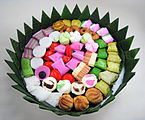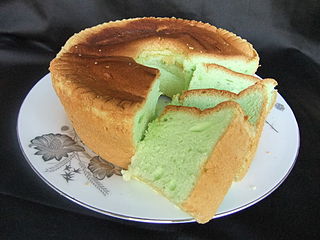
Pandan cake is a light, fluffy, green-coloured sponge cake flavoured with the juices of Pandanus amaryllifolius leaves. It is also known as pandan chiffon. The cake is popular in Malaysia, Indonesia, Singapore, Vietnam, Cambodia, Laos, Thailand, Sri Lanka, Hong Kong, China, and also the Netherlands. It is similar to the buko pandan cake of the Philippines, but differs in that it does not use coconut.
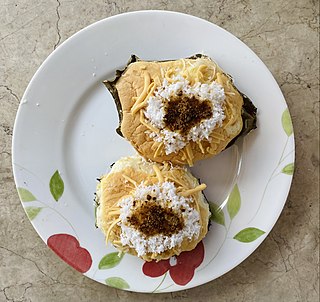
Bibingka is a type of baked rice cake in Filipino cuisine that is cooked in a terracotta oven lined with banana leaves and is usually eaten for breakfast or as merienda, especially during the Christmas season. It is also known as bingka in the Visayas and Mindanao islands.

Kue are bite-sized snacks or desserts originally from what is now Indonesia but have since spread throughout Southeast Asia. Kue is a fairly broad term in Indonesian to describe a wide variety of snacks including cakes, cookies, fritters, pies, scones, and patisserie. Kue are made from a variety of ingredients in various forms; some are steamed, fried or baked. They are popular snacks in Indonesia, which has the largest variety of kue. Because of the countries' historical colonial ties, Koeé (kue) is also popular in the Netherlands.

Spekkoek is a type of Indonesian layer cake. It was developed during colonial times in the Dutch East Indies. The firm-textured cake is an Indo (Dutch-Indonesian) version of the multi-layered rice cakes that are usually seen in Southeast Asian desserts but using some Dutch ingredients like flour and butter. It contains a mix of Indonesian spices, such as cardamom, cinnamon, clove, mace and anise. The cake is made of flour and yolk and is rich in butter or margarine.

Klepon or kelepon or kalalapun, also known outside Java as onde-onde and buah melaka, is a sweet rice cake ball filled with molten palm sugar and coated in grated coconut. Of Javanese origin, the green-coloured glutinous rice balls are one of the popular traditional kue in Indonesian cuisine.

Bika ambon or golden cake or golden kuih bingka in Singapore, is an Indonesian dessert made from ingredients such as tapioca flour, eggs, sugar, yeast and coconut milk. Bika ambon is generally sold in kaffir lime or pandan flavor, but today it is also available in other flavors like banana, durian, cheese and chocolate.

Kue putu or putu bambu is an Indonesian kue. It is made of rice flour and coloured green with pandan leaves, filled with palm sugar, steamed in bamboo tubes, and served with desiccated coconut. This traditional bite-sized snack is commonly found in maritime Southeast Asia, particularly in Java, Indonesia, where it is called putu bumbung. Kue putu is usually sold by street vendors and can be found in traditional markets, along with other kues. Kue putu can also be found in the Netherlands due to its colonial ties with Indonesia.

Clorot, celorot, cerorot, or jelurut is an Indonesian traditional sweet snack made of sweet and soft rice flour cake with coconut milk, wrapped with janur or young coconut leaf in cone shape. It is a popular traditional sweet snack commonly found in Brunei, Indonesia, and Malaysia.

Kue semprong, Asian egg roll, sapit, sepit, kue Belanda, or kapit, is an Indonesian traditional wafer snack made by clasping egg batter using an iron mold which is heated up on a charcoal stove. It is commonly found in Indonesia, Malaysia, Singapore and Brunei.

Bahulu or baulu is a traditional Malay pastry (kue/kuih). It is similar in concept to the madeleine cake, but round in shape and composed of different ingredients. There are three versions available, the most common being bahulu cermai (star-shaped) and the more elusive bahulu gulung and bahulu lapis (layered). Bahulu is believed to be originated in Malay Peninsula during the colonization era and is the corruption of the Malaccan Kristang word, bolu which means cake. It is usually served during Eid al-Fitr as well as during the Lunar New Year.

Betawi cuisine is rich, diverse and eclectic, in part because the Betawi people that create them were composed from numbers of regional immigrants that came from various places in the Indonesian archipelago, as well as Chinese, Indian, Arab, and European traders, visitors and immigrants that were attracted to the port city of Batavia since centuries ago.

Kue lapis is an Indonesian kue, or a traditional snack of steamed colourful layered soft rice flour pudding. In Indonesian, lapis means "layers". This steamed layered sticky rice cake or pudding is quite popular in Indonesia, Suriname and can also be found in the Netherlands through their colonial links.
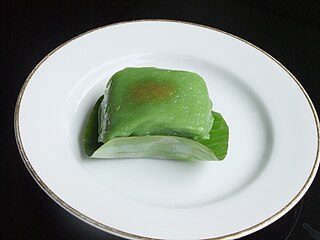
Kue bugis is Indonesian kue or traditional snack of soft glutinous rice flour cake, filled with sweet grated coconut. The name is suggested to be related to Bugis ethnic group of South Sulawesi as their traditional delicacy, and it is originated from Makassar. In Java the almost identical kue is called kue mendut or Koci Koci. Kue bugis, together with kue lapis and nagasari are among popular kue or Indonesian traditional sweet snacks, commonly found in Indonesian traditional marketplace as jajan pasar.

Kue gapit is an Indonesian kue kering which originates from Cirebon, West Java. Generally made from tapioca flour, its name comes from the cooking process, in which it is grilled between iron molds like a waffle. The snack comes in a variety of shapes and flavors. Though it is a popular souvenir among visitors to Cirebon, residents of the region rarely eat it.

Kue mangkok or kue mangkuk is an Indonesian kue or traditional snack of steamed cupcake. Kue mangkok means "bowl/cup cake". It is similar to the snack bolu kukus. While both have a similar appearance, bolu kukus requires few ingredients to make, whereas kue mangkok requires more than a dozen in most recipes. The result is a different texure: bolu kukus is soft and fluffy, while kue mangkok has a rough, often chewy and sticky texture.
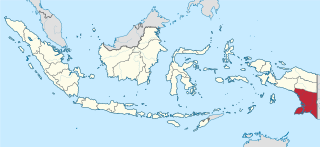
South Papua, officially the South Papua Province, is an Indonesian province located in the southern portion of Papua, following the borders of the Papuan customary region of Anim Ha. Formally established on 11 November 2022 and including the four most southern regencies that were previously part of the province of Papua and before 11 December 2002 had comprised a larger Merauke Regency, it covers a land area of 129,715.02 km2, about the same area as Pennsylvania. This area had a population of 513,617 at the 2020 Census, while the official estimate as at mid 2023 was 537,973, making it the least populous province in Indonesia.

Kue rangi or also called sagu rangi is an Indonesian coconut kue or traditional snack made of a coconut and starch-based batter and cooked in a special molded pan. It is one of the traditional Betawi snack of Jakarta. Kue rangi often described as Indonesian coconut waffle.

Kue bangkit is a small biscuit in Malay cuisine made from sago starch, commonly found amongst the Malay communities in Brunei, Indonesia, Malaysia and Singapore. This biscuit has various colours, ranging from white, yellowish to brown, depending on the additional ingredients.
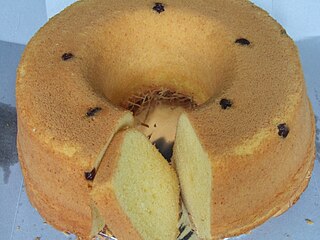
Kue bolu or simply bolu is an Indonesian term that describes a wide variety of sponge cakes, tarts and cupcakes.
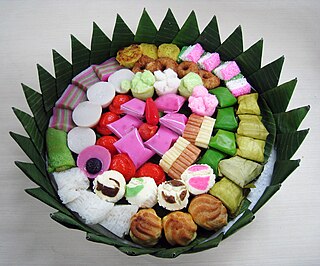
Jajan pasar refers to traditional Javanese cakes sold in Javanese markets.






















